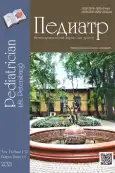Гиперэкплексия. Клиническое наблюдение
- Авторы: Фомина М.Ю.1, Мелашенко Т.В.1, Пальчик А.Б.1, Павлова О.И.1, Малеков Д.А.1
-
Учреждения:
- Санкт-Петербургский государственный педиатрический медицинский университет
- Выпуск: Том 12, № 4 (2021)
- Страницы: 83-88
- Раздел: Клинический случай
- URL: https://ogarev-online.ru/pediatr/article/view/90075
- DOI: https://doi.org/10.17816/PED12483-88
- ID: 90075
Цитировать
Аннотация
Дифференциальный диагноз пароксизмальных состояний, а также нарушений мышечного тонуса (гипертонуса) в неонатальном периоде и у детей раннего возраста достаточно сложен. Различные состояния нервной системы у новорожденных бывают транзиторными и перманентными, оптимальными и субоптимальными, нормальными и патологическими. Среди них можно упомянуть неэпилептические пароксизмальные состояния раннего детского возраста, которым в некоторых случаях сопутствуют двигательные нарушения, проявляющиеся чрезмерным повышением тонуса конечностей у новорожденных. Это патологическое состояние мышечного тонуса в англоязычной литературе обозначают термином stiffness baby (cиндром «ригидного» или «скованного» младенца). Неонатальный патологический мышечный гипертонус, в отличие от физиологического мышечного гипертонуса новорожденного, — достаточно редкое состояние. В статье приведены данные литературы и описание клинического наблюдения пациента с гиперэкплексией. Гиперэкплексия — это редкое пароксизмальное расстройство движения у детей раннего возраста. Рассмотрены основные клинические варианты заболевания, способы диагностики и коррекции, основные мутации, с которыми ассоциировано данное состояние. Представлено описание собственного клинического наблюдения пациента раннего возраста с гиперэкплексией, ее клиническая картина, особенности пароксизмальных состояний и терапии, данные нейровизуализации, электроэнцефалографических феноменов, регистрируемых у пациента, и генетического тестирования, подтвердившего диагноз неэпилептических пароксизмальных расстройств. У ребенка выявлена мутация в гене ATAD1, ассоциированная с гиперэкплексией 4-го типа (618011).
Ключевые слова
Полный текст
Открыть статью на сайте журналаОб авторах
М. Ю. Фомина
Санкт-Петербургский государственный педиатрический медицинский университет
Автор, ответственный за переписку.
Email: myfomina@mail.ru
д-р мед. наук, профессор кафедры неонатологии с курсами неврологии и акушерства-гинекологии ФП и ДПО
Россия, Санкт-ПетербургТ. В. Мелашенко
Санкт-Петербургский государственный педиатрический медицинский университет
Email: melashenkotat@mail.ru
канд. мед. наук, ординатор, Перинатальный центр, отделение реанимации и интенсивной терапии новорожденных
Россия, Санкт-ПетербургА. Б. Пальчик
Санкт-Петербургский государственный педиатрический медицинский университет
Email: Axander57@mail.ru
д-р мед. наук, профессор кафедры неонатологиии с курсами неврологии и акушерства-гинекологии ФП и ДПО
Россия, Санкт-ПетербургО. И. Павлова
Санкт-Петербургский государственный педиатрический медицинский университет
Email: eegenmg@mail.ru
ординатор, отделение функциональной диагностики
Россия, Санкт-ПетербургД. А. Малеков
Санкт-Петербургский государственный педиатрический медицинский университет
Email: d.a.malekov@gmail.com
ординатор, отделение лучевой диагностики
Россия, Санкт-ПетербургСписок литературы
- Иванов Д.О., Атласов В.О., Бобров С.А., и др.; ФГБУ Сев.-Зап. федеральный мед. исслед. центр им. Алмазова В.А., Ин-т перинатологии и педиатрии. Руководство по перинатологии / под ред. Д.О. Иванова. СПб.: Информ-Навигатор, 2015. 1214 с.
- Пальчик А.Б., Понятишин А.Е. Неэпилептические пароксизмы у грудных детей. М.: МЕДпреcс-информ, 2015. 136 с.
- Пальчик А.Б., Понятишин А.Е., Приворотская В.В. Неэпилептические пароксизмы у детей: структура и феноменология // Специальное образование. 2017. № 4. С. 129–140.
- Фомина М.Ю., Мелашенко Т.В., Павлова О.И. Неонатальные судороги у доношенных новорожденных: клинико-электрофизиологические особенности // Педиатр. 2018. Т. 9, № 5. С. 13–20. doi: 10.17816/PED9513-20
- Andrew M., Owen M.J. Hyperekplexia: abnormal startle response due to glycine receptor mutations // Br J Psychiatry. 1997. Vol. 170. P. 106–108. doi: 10.1192/bjp.170.2.106
- Bunod R., Doummar D., Whalen S., et al. Congenital immobility and stiffness related to biallelic ATAD1 variants // Neurol Genet. 2020. Vol. 6, No. 6. P. e520. doi: 10.1212/NXG.0000000000000520
- Chevrel J., Berthier M., Bonneau D., et al. Hyperexplexia // Arch Pediatr. 1995. Vol. 2, No. 5. P. 469–472. (In French) doi: 10.1016/0929-693x(96)81184-5
- Hmami F., Wood S.E., Chaouki S., et al. Neonatal hyperekplexia with homozygous p.R392H mutation in GLRA1 // Epileptic Disord. 2014. Vol. 16, No. 3. P. 354–357. doi: 10.1684/epd.2014.0663
- Li H., Yang Z.X., Xue J., et al. Clinical and genetic analysis of hyperekplexia in a Chinese child and literature review // Zhonghua Er Ke Za Zhi. 2017. Vol. 55, No. 2. P. 120–124. doi: 10.3760/cma.j.issn.0578–1310.2017.02.013
- Mine J., Taketani T., Yoshida K., Yokochi F., et al. Clinical and genetic investigation of 17 Japanese patients with hyperekplexia // Dev Med Child Neurol. 2015. Vol. 57, No. 4. P. 372–377. doi: 10.1111/dmcn.12617
- Moriyoshi H., Hata Y., Inagaki R., et al. A pedigree of hereditary hyperekplexia // Rinsho Shinkeigaku. 2018. Vol. 58, No. 7. P. 435–439. doi: 10.5692/clinicalneurol.cn-001129
- Piard J., Essien Umanah G.K., et al. ATAD1 encephalopathy and stiff baby syndrome: a recognizable clinical presentation // Brain. 2018. Vol. 141, No. 6. P. e50. doi: 10.1093/brain/awy100
- Gahlot SA, Pandey S. Hyperekplexia and other startle syndromes // Neurol Sci. 2020. Vol. 416. P. 117051. doi: 10.1016/j.jns.2020.117051
- Volpe J.J. Neurology of the Newborn. 5th Edition. Philadelphia: Saunders. Elsevier, 2008.
- Wolf NI., Zschocke J., Jakobs C., et al. ATAD1 encephalopathy and stiff baby syndrome: a recognizable clinical presentation // Brain. 2018. Vol. 141, No. 6. P. e49. doi: 10.1093/brain/awy095
Дополнительные файлы











